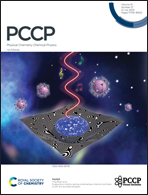Tunnel electroresistance effect in a two-dimensional organic ferroelectric tunnel junction
Abstract
Two-dimensional (2D) ferroelectric materials have important application potential in device miniaturization due to their characteristics of only being a few atomic layers thick and non-volatility. How to design high-performance ferroelectric memory devices based on 2D ferroelectric materials has attracted extensive attention. In this work, based on the 2D organic ferroelectric material semi-hydroxylized graphane (SHLGA), which has in-plane ferroelectric polarization along three different directions, we construct a 2D organic ferroelectric tunnel junction (FTJ). By means of density functional theory (DFT) and the non-equilibrium Green's function (NEGF) method, we calculate the transport properties of the FTJ under different polarizations and obtain a giant tunnel electroresistance (TER) ratio of 7.55 × 104%. We find that the mechanism behind the TER effect in the organic SHLGA is based on the unique built-in electric field. That is, among the three ferroelectric polarization directions, any two directions have an angle of 120°. As a result, the built-in electric fields along the transport direction of the FTJ under different ferroelectric polarization directions are different. Moreover, our study shows that the giant TER effect can also be achieved by utilizing the asymmetry of the polarization along the transport direction of the ferroelectric material itself, which provides another route for the design of 2D FTJs.



 Please wait while we load your content...
Please wait while we load your content...